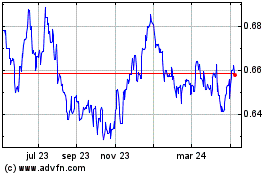Antipodean Currencies Fall Amid Risk Aversion
05 Diciembre 2024 - 8:12PM
RTTF2
Antipodean currencies such as the Australia and the New Zealand
dollars weakened against their major currencies in the Asian
session on Friday amid risk aversion, as traders remain cautious
and are reluctant to make significant moves ahead of the release of
the closely watched monthly U.S. jobs data later in the day that
will offer clues on the U.S. Fed's interest rate moves. Political
turmoil in South Korea and France also weighed on the investor
sentiment.
The U.S. jobs data could impact the outlook for interest rates
ahead of the Federal Reserve's next monetary policy meeting later
this month.
While traders have recently expressed greater confidence the Fed
will lower rates by another 25 basis points at the December
meeting, there remains uncertainty about the likelihood of
continued rate cuts at future meetings.
In France, President Emmanuel Macron said he will name a new
Prime Minister "in the coming days" to prevent the country from
sliding deeper into political turmoil.
Elsewhere in South Korea, President Yoon Suk Yeol faces
impeachment vote as early as Saturday tor trying to impose martial
law.
Investors are also looking at the possibility of further
reductions in the reserve requirement ratio by the Chinese central
bank this month.
Crude oil prices dipped, weighed by weak demand from China and
rising production in the United States - although the downside was
limited by OPEC's decision to delay a production increase. West
Texas Intermediate Crude oil futures for January fell $0.24 or 0.4
percent at $68.30 a barrel.
In the Asian trading, the Australian dollar fell to 2-day lows
of 0.6420 against the U.S. dollar and 96.30 against the yen, from
yesterday's closing quotes of 0.6450 and 96.80, respectively. If
the aussie extends its downtrend, it is likely to find support
around 0.61 against the greenback and 94.00 against the yen.
The aussie slid to a 1-month low of 1.6461 against the euro,
from Thursday's closing value of 1.6400. On the downside, 1.66 is
seen as the next support level for the aussie.
Against the Canada and the New Zealand dollars, the aussie
slipped to a 2-day low of 0.9014 and more than a 1-month low of
1.0948 from yesterday's closing quotes of 0.9044 and 1.0958,
respectively. The next possible downside target for the aussie is
seen around 0.89 against the loonie and 1.08 against the kiwi.
The NZ dollar fell to nearly a 3-week low of 1.8057 against the
euro and a 2-day low of 87.79 against the yen, from yesterday's
closing quotes of 1.7985 and 88.31, respectively. If the kiwi
extends its downtrend, it is likely to find support around 1.82
against the euro and 87.00 against the yen.
Against the U.S. dollar, the kiwi edged down to 0.5855 from
Thursday's closing value of 0.5884. The kiwi may test support near
the 0.56 region.
Looking ahead, Eurostat releases euro area revised GDP data for
the third quarter at 5:00 am ET in the European session. The
initial estimate showed that the currency bloc expanded 0.4 percent
sequentially.
In the New York session, U.S. and Canada jobs data for November,
Canada Ivey PMI for November, U.S. University of Michigan consumer
sentiment index for December and U.S. Baker Hughes oil rig count
data are slated for release.
AUD vs US Dollar (FX:AUDUSD)
Gráfica de Divisa
De Nov 2024 a Dic 2024

AUD vs US Dollar (FX:AUDUSD)
Gráfica de Divisa
De Dic 2023 a Dic 2024
